Subaru Outback (BR): CVTF
A: INSPECTION
Check for leakage of CVTF from transmission.
B: ADJUSTMENT
CAUTION:
- CVTF level changes along with CVTF temperature. When inspecting CVTF level, observe the specified CVTF temperature.
- Always use specified CVTF or equivalent. Using other fluid than specified or equivalent will cause malfunction.
1) Idle the engine to raise CVTF temperature to 35 - 45ºC (95 - 113ºF) on Subaru Select Monitor.
2) Operate the select lever in P → R → N → D and D → N → R → P to circulate CVTF with the engine idling.
3) With the engine running, lift up the vehicle and remove the filler plug.
CAUTION: Pay special attention to the following operations as the engine is at idle.
NOTE: CVTF is at the specified level when it is up to the filler plug hole lower section.
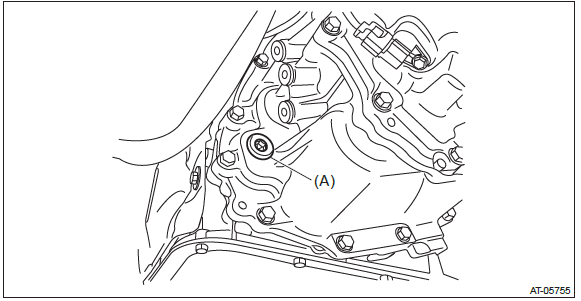
- Filler plug
4) When there is no CVTF leakage from the transmission, add the specified fluid or equivalent up to the filler plug hole lower section.
CVT fluid: <Ref. to CVT-4, HYDRAULIC CONTROL AND LUBRICATION, SPECIFICATION, General Description.>
CAUTION: Note that when CVTF is added up to the lower section of filler plug while the transmission is in cold condition, overfilling of CVTF occurs, causing the oil to spill out.
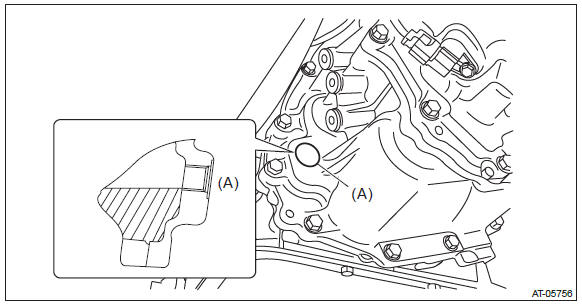
- Filler plug hole
5) Install the filler plug.
NOTE: Use a new gasket.
Tightening torque: 50 N*m (5.1 kgf-m, 36.9 ft-lb)
C: REPLACEMENT
CAUTION:
- Directly after the vehicle has been running or the engine has been long idle running, the CVTF is hot. Be careful not to burn yourself.
- Be careful not to spill the CVTF on exhaust pipe to prevent it from
emitting smoke or causing fires.
If CVTF adheres, wipe it off completely.
- Always use specified CVTF or equivalent. Using other fluid than specified or equivalent will cause malfunction.
1) Lift up the vehicle, and remove the CVTF drain plug.
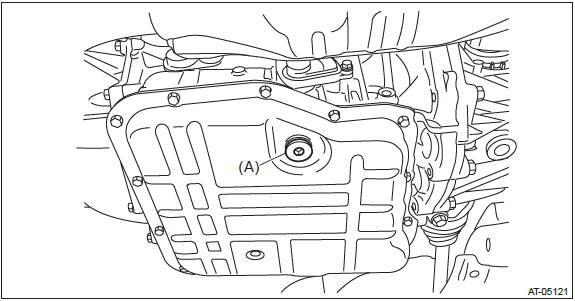
- CVTF drain plug
2) Check the CVTF condition. <Ref. to CVT-40, CONDITION CHECK, CVTF.>
3) Install the CVTF drain plug and gasket.
NOTE:
- Use a new gasket.
Tightening torque: 20 N*m (2.0 kgf-m, 14.8 ft-lb)
4) Remove the filler plug.
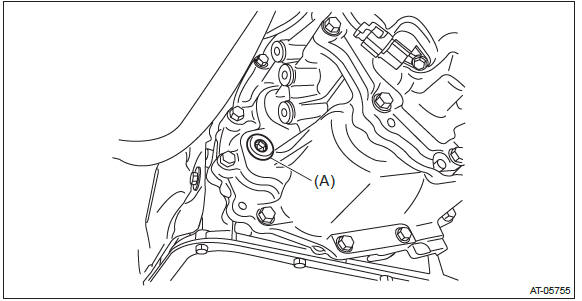
- Filler plug
5) Fill in the specified fluid or equivalent through the filler plug.
CVT fluid: <Ref. to CVT-4, HYDRAULIC CONTROL AND LUBRICATION, SPECIFICATION, General Description.>
Capacity: Fill with the same amount of CVTF as drained.
6) Temporarily tighten the filler plug.
7) Idle the engine to raise CVTF temperature to 35 - 45ºC (95 - 113ºF) on Subaru Select Monitor.
8) Operate the select lever in P → R → N → D and D → N → R → P to circulate CVTF with the engine idling.
CAUTION: Pay special attention to the following operations as the engine is at idle.
9) Place the select lever in "P" range. Then lift up the vehicle with the engine at idle to adjust the CVTF level and check for leakage. <Ref. to CVT-37, ADJUSTMENT, CVTF.>
10) Replace with a new gasket, and attach the filler plug.
Tightening torque: 50 N*m (5.1 kgf-m, 36.9 ft-lb)
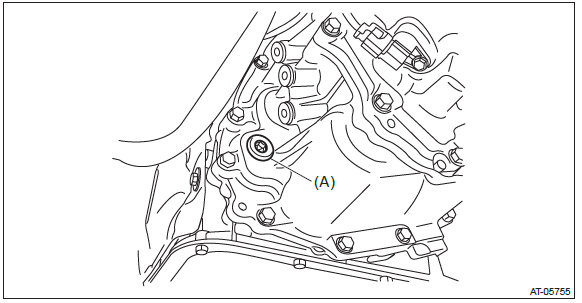
- Filler plug
D: CONDITION CHECK
NOTE: When replacing CVTF, determine the condition inside the transmission body by inspecting the drained CVTF.


